Late Saturday afternoon the phone rang, with news of a helicopter missing in Taplejung with doctors and Sherpas on board-the caller was checking to make sure it wasn't me. I switched on the television, hoping and praying that the helicopter had made a forced landing and that those on board were safe. There were far too many names on the passenger list who were my friends and professional colleagues for over 30 years, each with hopes, aspirations, and opportunities ahead. They were pillars of Nepal's much needed conservation efforts, and pivotal at this point in our environmental history. As hours, then days, ticked by in incessant rain, our worst fears were confirmed.
I travelled to Kangchenjunga in August 1994 to carry out a study and its feasibility for protected area status. Like a Buddhist mountain deity, the area displayed both peaceful and wrathful manifestations. On a clear day, the beauty of the ancient forests and gushing waterfalls, interspersed with lush grasslands and agricultural settlements was unparalleled.
Still, the impossibly rugged terrain and heavy monsoon rains can quickly turn this hidden paradise into a ferocious landscape of thunder clouds, rain, and unpredictable landslides into the violent Tamur River. Sadly, it was the latter manifestation that my friends and colleagues encountered on 23 September.
Although I cannot speak for them today, I do know that it was this remarkable versatility and variation in Nepal's landscapes which inspired them to do the work they did.
Narayan Prasad Paudel was recently promoted to director-general at the Department of National Parks and Wildlife Conservation (DNPWC), a hard-earned achievement for a career bureaucrat in the conservation field for over 30 years. He studied forestry and had a Master's in Natural Resource Economics. 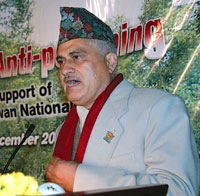
MIN BAJRACHARYA
Narayan and I served together in the same department for many years. He was leader of the team that made the Makalu-Barun National Park and Conservation Area in Arun Valley a reality. In recent years he worked hard to ensure the Sagarmatha National Park upgrades its management system through participatory planning processes. As chief ecologist of the DNPWC, he was especially concerned with ensuring that national parks be vigorously protected in these uncertain times.
Narayan did not drink or smoke. He was calm and friendly, and the only times anyone ever thought he was rude were a result of frequent mix-ups with his identical twin. He was always polite and encouraging to co-workers, and when he became director-general, some even questioned how someone so nice could govern such a difficult department. But Narayan handled his post with calm assurance, never becoming caught up in the status of his position, and always seeking input from his staff and outsiders. For many he was a good role model.
Narayan was a deeply spiritual person and should have been celebrating Ghatasthapana on that fateful day. At the same time, he was extremely conscientious and polite, and would never have turned down a request to attend the ceremony handing over the Kangchenjunga Conservation Area to the local community. The task was part of his responsibilities, and he always believed in empowering and supporting protected area residents. Narayan Poudel leaves behind his wife, Chanda and daughter Reecha. I hope they realise that there are many people like myself who appreciate his contributions and will miss him badly.
Chandra Prasad Gurung Despite being from different parts of Nepal, I came to know Chandra well when he joined the feasibility study team for the Annapurna Conservation Area Project (ACAP). Chandra was from the village of Sikles, within the proposed Annapurna Conservation Area. As a local, he had an instrumental role in ensuring local support for the project. Chandra had a PhD in medical geography, but after his involvement in ACAP he took up conservation and protected areas management as his profession, quickly learning the art of conservation and performing excellently. 
COURTESY: WWF-NEPAL
At international conferences and workshops, Chandra was an excellent presenter and speaker. With him around, Nepal was always well represented at camp fires and parties because he was also an exceptional singer and performer.
Chandra Gurung served as the director of Annapurna Conservation Area and then member-secretary of the King Mahendra Trust for Nature Conservation. He was Country Representative for WWF-Nepal over the last eight years, during which time he grew the WWF-Nepal Office to a strong, well-funded conservation institution. He believed in good publicity as a tool to achieve high-profile conservation work. The last time I met Chandra, at Bangkok airport about two months ago, I asked which of WWF-Nepal's projects was looking most promising.
"The Tarai Arc Landscape Project," he replied. I hope the WWF staff will be able to carry on Chandra's legacy, dreams, and pride. He will be missed by the Gurung community and his family and by conservation as a whole.
Mingma Norbu Sherpa and I spent many years together, at Ananda Kuti High School in Kathmandu, as university students in New Zealand, and later as colleagues in the DNPWC. Mingma was one of the first Sherpas to go through high school and university, and more uniquely to join the government service. 
ANNE B KEISER IN 'SIR EDMUND HILLARY & THE PEOPLE OF EVEREST'
Mingma was always a go-getter. He took Sir Edmund Hillary as his mentor and role model, and followed his motto 'nothing ventured, nothing gained'. Mingma was a keen outdoor sportsman and liked climbing, skiing and even water sports. Coming from the mountains, swimming was not one of our strengths, but Mingma always dove right in, resulting in a few close calls. Laughing about those close shaves were among our fondest moments as friends.
Over the years, Mingma made remarkable contributions. He served as warden of Sagarmatha National Park and worked on the planning of the Annapurna Conservation Area. Even after he moved to the USA to work for the WWF, he supported conservation in Nepal and Bhutan, and his heart and mind always remained in Asia.
Mingma went from being a barefoot Khumbu child to conservation director for Asia Pacific Program of WWF-USA. He made remarkable contributions to Nepal and died doing the work he was most committed to. He was a valued member of the Sherpa community, and is survived by his wife Phurba, son Tenzing and daughter Dawa. We pray that our shared Sherpa and Buddhist beliefs will help them cope with this irrecoverable loss.
Dr Tirtha Man Maskey was a pioneer in the establishment of Nepal's protected areas system. He became the first warden of Chitwan National Park in 1972 and earned his PhD from the University of Florida in 1979. His contribution to gharial conservation work in Chitwan National Park is particularly well known. Dr Maskey was one of the longest serving director-generals of the DNPWC. He was known to have a sharp tongue, but be extremely well-meaning. He oversaw Nepal's protected areas through a very difficult period of conflict and insurgency. 
MIN BAJRACHARYA
Born in Kathmandu, Dr Maskey had travelled all over Nepal to oversee the national parks and reserves.
Although his first love was always the rhinos, tigers, and gharials of the tarai, he was equally fond of the high mountain areas. He was great on social occasions, and loved laughing and chatting with friends and staff alike.
Though Dr Maskey retired from government service at the end of 2005, he kept working. He became co-chair of IUCN's Asian Rhino Specialist group, and was working in collaboration with WWF-Nepal when the fateful incident took place. Nepal's conservation community will miss his contributions. We extend our deepest condolences to his wife Laxmi, and sons Jason and Ayush.
Dr Damodar Parajuli, senior official at the Ministry of Forest and Soil Conservation for many years, had a special interest in non-timber forest products. He conducted his doctoral research in India on Himalayan yew (Taxus sp), a promising source for cancer treatment. He was known for his unfailing smile and "ke chha" for everyone. Soft-spoken and pleasant, he took a great interest in the work and lives of ministry staff. 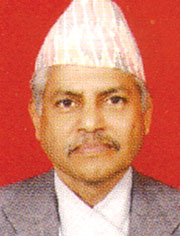
COURTESY: WWF-NEPAL
After joining government service in 1974, he served in many districts as District Forest Officer over the years. He was director-general of the Forest Department, and was recently in charge of the Foreign Aid Division before becoming acting secretary of the ministry. He is survived by his wife, four daughters, and a son.
Sarad Kumar Rai was born in 1955 in Khotang. A career forester with the Department of Forests, he served in District Forest Offices in many districts over the years, both in the hills and tarai. More recently, he served as a planning officer and had a special interest in community forestry with the Department in Kathmandu. He was recently appointed director general in the Department of Forests. Sarad Rai was one of the few high ranking forestry officials from the Rai community. With his loss there will be less diversity and experience within the Ministry. He is survived by his wife Kabita and two sons, and will be sorely missed. 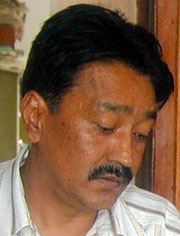
COURTESY: WWF-NEPAL
Lhakpa Norbu Sherpa
Cheers, Pauli 
ALL PICS: WWF
A few days before he left for his ill-fated trip, Pauli Mustonen, the Finnish Charge d'Affaires in Kathmandu, was organising a concert by Aavas at his residence. We scheduled it for 24 September, after his return from Taplejung. The concert will never happen.
Pauli was much more than a diplomat. He was a quiet, humble man who wanted to do something good for Nepal and Nepalis, but would never take credit for good results. He loved music and came to every Nepathya and Paleti show possible.
Pauli had great plans, and they always reflected Nepali desires. He wanted to see all Nepali children going to school. He wanted Palpasa Caf? to be translated and published in Finnish. He wanted the picture book Kunda Dixit put together, A People War, and the images in it, to reach as many people as possible within and beyond Nepal. Pauli wanted to do what he could to ensure Nepal's forests were conserved as those in Finland.
Pauli wanted to go back to Peru, where he had served before. He loved music, and food, and never refused a drink. Above all, Pauli was filled with love for life and a sense of purpose. Music has lost a good listener and Nepal, an ever better friend.
Kiran Krishna Shrestha 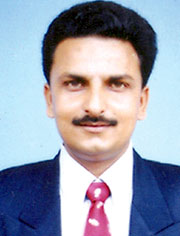 Sunil Singh
Sunil Singh
NTV cameraman Sunil Prasad Singh was born in Sarlahi 31 years ago, and joined Nepal Television to man studio cameras in 1997. He worked at the Kohalpur regional transmission centre for several years and then at the central office.
Dedicated, quiet, and very warm, Singh had won various awards for his work. He had only started working as a news cameraman two months ago.
Sunil is survived by his wife and two daughters, who are now faced with a serious crisis. Sunil's wife is an Indian citizen, and as their marriage was not registered, his daughters do not have citizenship either, and the family are not entitled to insurance claims.
Sunil's colleagues at NTV will remember him as being very committed, and will miss his contributions greatly.
Ram Sharan Mahat, Kantipur TV  Vijaya Shrestha
Vijaya Shrestha
Vijaya Shrestha was a rare individual who, besides being a successful businessman, also worked to raise social and political consciousness in his home district of Taplejung. As a recent president of the Taplejung Chamber of Commerce and Industry and the Mechi zonal representative, Shrestha was also executive member of the Federation of Nepalese Chambers of Commerce and Industry. He contributed greatly to the establishment and development of the Taplejung Chamber of Commerce and Industry, and always emphasised unity.
Shrestha was involved in exporting tea and other local produce from Taplejung to the Indian market. Vijaya Shrestha leaves behind a wife and two children.
Nepali Times
Hemraj Bhandari 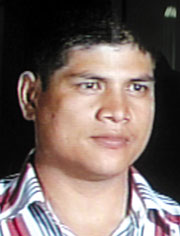
COURTESY: NTV
In the 15 months that Hemraj Bhandari worked as a reporter and news editor at Nepal Television, he carved a niche for himself as one of NTV's most diligent and inquisitive staff. Efficient and professional, Hemraj loved doing in-depth reports on development, environmental, and public concern issues.
Hemraj was a well-educated, bilingual reporter, and used his work to push for better education and health programs, especially in the mid- and far-western regions. Hemraj was born in the remote village of Ghodagaon in Rolpa in 1979, and won a prestigious scholarship to Budhanilkantha School.
Hemraj was also a good speaker and leader, and was a valuable member of the Society of Ex-Budhanilkantha Students' Association, actively involved in their free health camps. Always conscious of his roots, Hemraj also worked hard to generate funds for the SEBS scholarship program.
Hemraj was passionate, determined, and innovative when it came to his work. Just two weeks ago, he had rushed in at 8PM to cover the pre-launch of the picture book A People War and refused to be deterred by loadshedding. He conducted the interview by candlelight, and it was ready to air on the 10.15 news. The loss of such a passionate, promising journalist is a blow to the nation.
Devendra Dhungana, NTV
Jillian Bowling Schlaepfer 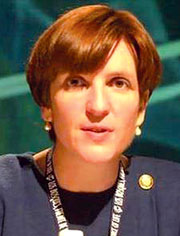
COURTESY: WWF
Jill had worked as WWF-UK's director of programs since July 2004, supporting conservation programs tackling global threats such as climate change through business and government advocacy strategies.
A Swiss-Australian, Jill had also worked with WWF-International as deputy director of the Forests Program for two years. Prior to that, she worked as a director at the International Federation of Building and Wood Workers in Switzerland, in the Oregon Department of Forestry (USA) and in the Australian Federal Public Service.
Hannah Williams, WWF-UK
Jennifer Headley 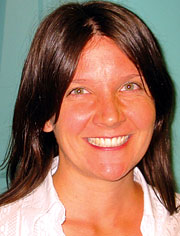
COURTESY: WWF
Jennifer Headley joined WWF-UK in August 2003. As coordinator for the Himalaya/South Asia Programme, she promoted community-based species conservation and forestry, plantations, and natural forest regeneration. Jennifer also educated people about climate change. She had been based in Nepal since 2005, focusing on the eastern Himalayas.
A Canadian national, Jennifer first came to Kathmandu in 2001 and worked through CECI on species conservation and natural resource management. Before that, she had lived and worked in the Canadian Arctic.
She was an important part of Nepal's WWF family. Her friends remember her as being feeling a strong sense of accomplishment about developing a program approach. Jennifer is survived by her parents and two sisters.
Headley family, Hannah Wiliams, WWF-UK
Bijnan Acharya 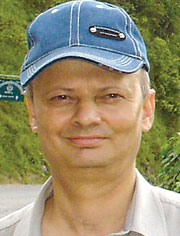
COURTESY: USAID
Born was born in Tanahaun district into a family of poets, and Bijnan grew to be a leading environmentalist here. He earned a doctorate on Forest and Biodiversity Assessment from Leiden University in the Netherlands, and authored numerous scholarly articles.
Bijnan served at the Ministry of Forests and Soil Conservation in various capacities until he joined USAID in 1999 as the Environment and Forestry Program Specialist. He was also the mission Environmental officer responsible for ensuring that every USAID project met environmental safety standards before implementation.
Bijnan managed complex programs dealing with community forests, buffer zones, irrigation schemes, and hydropower. He also contributed immensely to Nepal's community-based approach to management of forests and buffer zones, regarded as a highly successful model. He maintained a personal and heartfelt dedication to his work.
Bijnan was a true gentleman. He will be missed dearly, and is survived by his wife, son, daughter, parents, two brothers, and two sisters.
USAID
Margaret Alexander 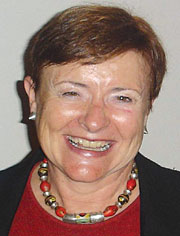
COURTESY: USAID
Margaret Alexander arrived in Kathmandu as deputy director of USAID in 2005, and worked on the peace building and reconciliation process and as a strong advocate for essential development programs. A natural leader, she often served as the acting director of the mission, including during the recent helicopter trip.
Margaret was energetic, courageous, good-natured, and truly inspiring. She previously served in Cote d'Ivoire, Haiti, Kenya, and the Europe and Eurasia Bureau, and tookt pleasure in learning about each place's people and cultures.
The day of the ceremony in Kanchenjunga, USAID announced her next assignment, mission director in the Democratic Republic of Congo. Margaret's friends from around the world are still sending condolence letters.
USAID
Matt Preece 
COURTESY: WWF
Matthew Preece was born in 1975 in New York, but travelled all over the world. He loved people and the outdoors, and was able to combine both in his work in environmental education.
He received his MA in Sustainable International Development in 2004 from Brandeis University in Boston. After internships and consultancies in several countries, Matt joined WWF-Nepal in May 2006 as program officer for the Eastern Himalaya Eco-region Complex. He was particularly interested in hands-on environmental work and teaching conservation.
Matt also spent several months in Bangalore helping locals learn to use natural resources in eco-friendly and sustainable ways. He also led groups of students to study the ecology of coastal Mexico and to help preserve the sea turtles of Costa Rica.
Matt loved to travel and experience life. His humorous emails of experiences overseas and the pictures of his adventures will be greatly missed. He was excited to begin work at the WWF, and felt lucky to work on something he believed in.
Matt is survived by his parents, four siblings, and 11 nieces and nephews. Matt's family and friends worldwide will miss his sense of humour and generosity of spirit, but he died doing what he loved, and for that we are grateful.
Debbi Wooten, sister
Shree Airlines Crew
Captain Klim Kim was from Kyrgystan and joined Shree Airlines about a year ago.
Flight engineer Valeriy Safronov was Russian.
Captain Mingma Sherpa had joined Shree Airlines just last week, and previously worked for Alliance Helicopters.
Cabin attendant Guruwar Tandul was from Bagbazar. He is remembered by colleagues as a friendly and sincere young man.


